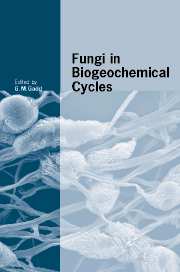Book contents
- Frontmatter
- Contents
- List of Contributors
- Preface
- 1 Geomicrobiology: relative roles of bacteria and fungi as geomicrobial agents
- 2 Integrated nutrient cycles in boreal forest ecosystems – the role of mycorrhizal fungi
- 3 Fungal roles in transport processes in soils
- 4 Water dynamics of mycorrhizas in arid soils
- 5 Integrating ectomycorrhizal fungi into quantitative frameworks of forest carbon and nitrogen cycling
- 6 Role of arbuscular mycorrhizal fungi in carbon and nutrient cycling in grassland
- 7 The role of wood decay fungi in the carbon and nitrogen dynamics of the forest floor
- 8 Relative roles of bacteria and fungi in polycyclic aromatic hydrocarbon biodegradation and bioremediation of contaminated soils
- 9 Biodegradation and biodeterioration of man-made polymeric materials
- 10 Fungal dissolution and transformation of minerals: significance for nutrient and metal mobility
- 11 Fungal activities in subaerial rock-inhabiting microbial communities
- 12 The oxalate–carbonate pathway in soil carbon storage: the role of fungi and oxalotrophic bacteria
- 13 Mineral tunnelling by fungi
- 14 Mineral dissolution by ectomycorrhizal fungi
- 15 Lichen biogeochemistry
- 16 Fungi in subterranean environments
- 17 The role of fungi in carbon and nitrogen cycles in freshwater ecosystems
- 18 Biogeochemical roles of fungi in marine and estuarine habitats
- Index
- References
15 - Lichen biogeochemistry
Published online by Cambridge University Press: 10 December 2009
- Frontmatter
- Contents
- List of Contributors
- Preface
- 1 Geomicrobiology: relative roles of bacteria and fungi as geomicrobial agents
- 2 Integrated nutrient cycles in boreal forest ecosystems – the role of mycorrhizal fungi
- 3 Fungal roles in transport processes in soils
- 4 Water dynamics of mycorrhizas in arid soils
- 5 Integrating ectomycorrhizal fungi into quantitative frameworks of forest carbon and nitrogen cycling
- 6 Role of arbuscular mycorrhizal fungi in carbon and nutrient cycling in grassland
- 7 The role of wood decay fungi in the carbon and nitrogen dynamics of the forest floor
- 8 Relative roles of bacteria and fungi in polycyclic aromatic hydrocarbon biodegradation and bioremediation of contaminated soils
- 9 Biodegradation and biodeterioration of man-made polymeric materials
- 10 Fungal dissolution and transformation of minerals: significance for nutrient and metal mobility
- 11 Fungal activities in subaerial rock-inhabiting microbial communities
- 12 The oxalate–carbonate pathway in soil carbon storage: the role of fungi and oxalotrophic bacteria
- 13 Mineral tunnelling by fungi
- 14 Mineral dissolution by ectomycorrhizal fungi
- 15 Lichen biogeochemistry
- 16 Fungi in subterranean environments
- 17 The role of fungi in carbon and nitrogen cycles in freshwater ecosystems
- 18 Biogeochemical roles of fungi in marine and estuarine habitats
- Index
- References
Summary
Introduction
This volume focuses primarily on the influence of free-living fungi in biogeochemistry. Lichens, fungi that exist in facultative or obligate symbiosis with one or more photosynthesizing partners, also play an important role in many biogeochemical processes. Pioneer colonizers of fresh rock outcrops, lichens were possibly one of the first life forms to occupy Earth's land surfaces. The unique lichen symbiosis formed between the fungal partner (mycobiont) and the photosynthesizing partner, an alga or cyanobacterium (photobiont), enables lichens to grow in all surface terrestrial environments. These include extreme environments where no other multicellular vegetation can survive, such as the dry Antarctic valleys (Nash, 1996). An estimated 6% of the Earth's land surface is covered by lichen-dominated vegetation.
Globally, lichens play an important biogeochemical role in the retention and distribution of nutrient (e.g. C, N) and trace elements (e.g. Knops et al., 1991; Garty et al., 1995), in soil formation processes (Ascaso et al., 1976; Jones, 1988) and in rock weathering (Hallbauer & Jahns, 1977; Wilson et al., 1981; Wessels & Schoeman, 1988; McCarroll & Viles, 1995; Barker et al., 1997; Lee & Parsons, 1999). Lichens tend to accumulate trace elements such as lead, copper and other heavy metals of environmental concern (see below), including radionuclides (Yliruokanen, 1975; Nieboer & Richardson, 1981; Beckett et al., 1982; Boileau et al., 1982, 1985a, b; Richardson et al., 1985; Fahselt et al., 1995; Haas et al., 1998; McLean et al., 1998; Jacquiot & Daillant, 1999; Purvis et al., 2004).
- Type
- Chapter
- Information
- Fungi in Biogeochemical Cycles , pp. 344 - 376Publisher: Cambridge University PressPrint publication year: 2006
References
- 28
- Cited by



